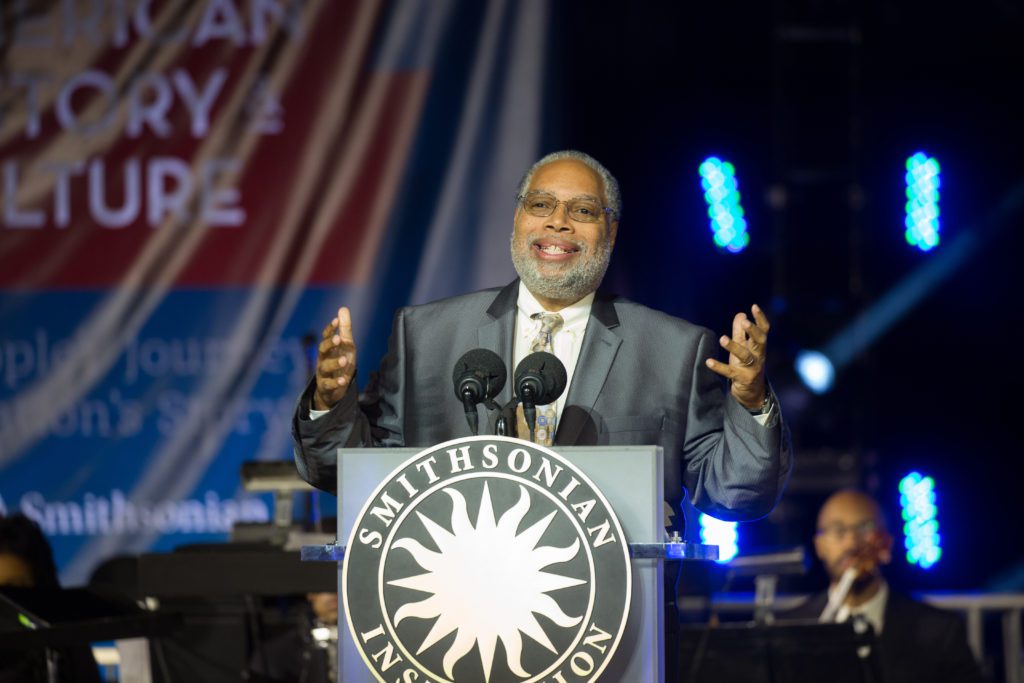A Conversation With Lonnie Bunch
By • October 11, 2017 0 920

When most people think of Lonnie G. Bunch III, they think about the Smithsonian’s National Museum of African American History and Culture, which he has served as director for the past 10 years. When I think of this historian, curator and author, I also think of his roots.
Lonnie Bunch’s mother is from the small town of Woodland, North Carolina, six miles from where I was born and raised. Decades apart, his mother and I attended W. S. Creecy High School and Shaw University.
Because of that connection, we started the interview discussing those roots. He recalled his ancestors, dirt roads, creeks and names that only people with rural North Carolina roots can pronounce correctly. He talked about his mother, Montrose Boone, and his father, Lonnie G. Bunch Jr., both educators. He wondered aloud how his grandfather purchased the land the Boone family still owns in Northampton County. I wanted to discuss his mother because she is still alive and had a front seat to history when the new museum on the National Mall opened under her son’s leadership.
When he speaks of his mother, he is no longer the scholar but the son of a woman who endured the hardships of the South and the difficulties of raising two black sons, even after the family moved to New Jersey.
“What does your mother have to say about the museum and all she witnessed the 10 years you worked on this massive project?” I asked, in between naming places and people that we both knew and loved.
“She is very proud as a mother and educator, who understands what this museum means to the world. She understands the impact it will have on generations to come, but she also understands the struggle,” he said.
Struggle is an understatement, considering that he was the pilot in raising $450 million and traveling the world to gather the donations and the artifacts. When you talk to him, you realize he went everyplace except the henhouse to get everything from slave documents to Motown records.
The nearly 400,000-square-foot space that was designed by David Adjaye will make you smile when you look at Chuck Berry’s red Cadillac and make you cry at the sight of young Emmett Till’s casket. No matter how hard the challenge to gather these archives and find funding, he never moved away from the task at hand. When he agreed to return to the Smithsonian, he knew the job would not be easy.
In many ways, Lonnie Bunch’s position as founding director of the museum represented a homecoming. He was back at the Smithsonian, where the journey started for him at the National Air and Space Museum. After teaching at the University of Massachusetts– Dartmouth and Packer Collegiate Institute in Brooklyn, he left for Los Angeles, where he worked as curator of history and program manager at the California African American Museum from 1983 to 1989. While there, he organized several award-winning exhibitions, including “The Black Olympians, 1904–1950” and “Black Angelenos: The Afro-American in Los Angeles, 1850–1950.” He also produced several historical documentaries for public television.
Returning to Washington, D.C., he held numerous positions at the National Museum of American History from 1989 through 2000. Then, in 2001, he became president of the Chicago Historical Society, where he created the Teen Chicago Program. This program enlisted teenagers to conduct oral history interviews and collect artifacts from older members of their communities. It helped to form an award-winning exhibition that thousands came to see. Later, the Chicago Historical Society was transformed into the Chicago History Museum.
The Chicago History Museum had become a perfect fit, and Chicago was perfect for him, his wife and two daughters. He had no plans to leave when the Smithsonian asked him to return. (He admits that he said no to the Smithsonian three times, until he couldn’t refuse anymore.) He knew the call was too great, so he came back to a world stage and to an effort — creating the new museum — that would take 10 years, with many more years of work to come.
He is modest about what he has done. He comes without fanfare and clearly is not seeking fame, but the awards and honors never stop. The American Association of Museums named him one of the 100 most influential museum professionals of the 20th century. He was appointed to the Committee for the Preservation of the White House in 2002 by George W. Bush, and reappointed in 2009 by Barack Obama.
No matter how many awards he has, when the sun sets, Lonnie Bunch is still teaching us the way he did at the beginning of his career and later at George Washington University. He may not be in the classroom, but the lessons are still there.
In between talking about dirt roads in North Carolina and the archives he would still like to have at the museum, he told me about the personal document he would love to touch with his own hands. It was something simple, but yet so beautiful. “I would like to have my dad’s application to Shaw University. I would like to know what he wrote so long away,” he said.
On his bucket list for the museum, he wants Willie Mays’s baseball more than anything he can think of at the moment. For a man who has stood the test of time and given so much to the world, I am sure he will one day get both.

